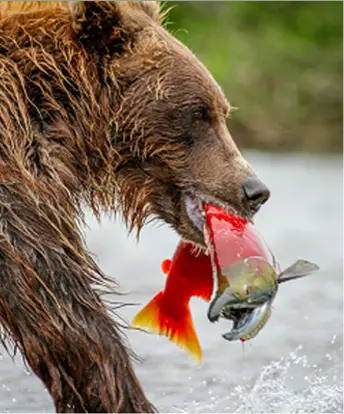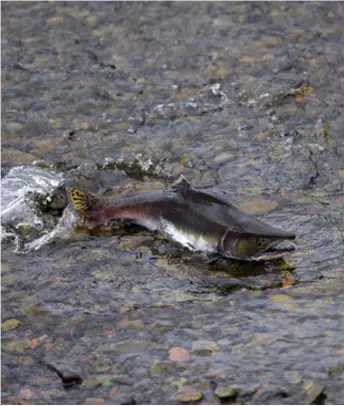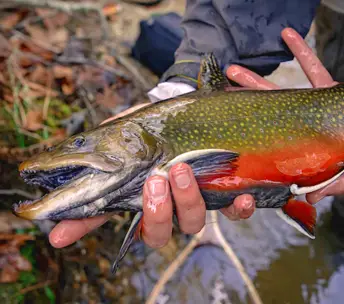Explore Alaska’s Gold

Aptly Dubbed the Last Frontier
Alaska is a state with an unparalleled abundance of wilderness, surpassing any other region in the contiguous United States. It boasts 17 of the 20 highest peaks in North America, over 100,000 glaciers, more than 3,000 rivers and 3 million lakes. Alaska’s vast and diverse landscapes are home to an astonishing variety of wildlife, including moose, caribou, Dall sheep, whales, puffins, bald eagles, sea lions, sea otters, and an impressive population of 30,000 brown bears.
The state’s fisheries are among the healthiest, most varied, and most sustainable in the world. Alaska’s seafood is considered one of the state’s greatest treasures, often referred to as “Gold.” The vast number of oceans, lakes, rivers, and other bodies of water make it an ideal habitat for a variety of fish, including char, Pacific herring, halibut, salmon, black rockfish, pollock, shrimp, clams, octopus, white sturgeon, various types of whitefish, and king crab. Visitors have ample opportunities to sample local specialties and savor the flavors of Alaska’s bountiful seafood offerings.
When it comes to discussing Alaskan seafood, a great place to start is the state’s constitution. Unlike many other significant fisheries around the world, Alaska’s resources, including salmon, are managed for maximum sustainable yield. This unique approach means that fisheries must take responsibility for ensuring the health of their wild stock and protecting against pollution, overfishing, and other harmful factors that could threaten the state’s fish population. Not only does this preserve the industry for future generations, but it also ensures that the seafood is of the highest quality.
One such example of sustainable fishing is Copper River Salmon, a rural fishing collective based in the tiny fishing town of Cordova. This grassroots effort centers around coho, sockeye, and king salmon caught from the nearby Copper River Delta, which is rich in nutrients and located adjacent to the stunning Prince William Sound.
In Cordova and other fishing towns like it, the Alaska Department of Fish and Game works hand in hand with local communities to manage all fisheries and ensure that abundant future stocks are maintained. This involves limiting fishing through carefully monitored time and location restrictions. It’s a delicate balancing act that ensures the long-term health of the ecosystem while still allowing for a thriving and vibrant industry.

Sustainability
Alaska’s commitment to sustainable fishing doesn’t stop at managing wild stock. Another state law that sets it apart from other regions and makes Alaskan seafood some of the best available is its strict regulation of fish farms or aquaculture. While some states allow for a wide range of aquaculture, Alaska has taken a different approach. Currently, only farming for shellfish and seaweed is allowed, meaning that the rest of the state’s fish is entirely wild-caught.
This law has several important benefits. Firstly, it eliminates the risk of farmed fish escaping and interbreeding with wild stock, which can harm the genetic diversity and overall health of the ecosystem. Secondly, it helps to maintain a balance between supply and demand in the market, ensuring that prices remain stable and that the industry remains profitable for those who rely on it for their livelihoods.

Additionally, Alaska’s regulation of aquaculture helps to preserve the state’s natural beauty and protect the environment. By preventing the spread of pollutants and disease that can be associated with fish farms, Alaska can maintain the pristine condition of its waters, which are a crucial part of the state’s unique ecosystem.
Alaska’s approach to aquaculture is just one more way that the state is leading the way in sustainable fishing practices. By prioritizing the health of wild stock, protecting against potential harm from farmed fish, and safeguarding the environment, Alaska is setting an example that other regions would do well to follow.
Alaska’s Bounty: Pristine Oceans
Alaska’s oceans are renowned for their pristine quality and exceptional water clarity. With over 33,000 miles of coastline, the state boasts some of the cleanest and most unspoiled marine environments in the world.
One of the key factors contributing to Alaska’s high water quality is its geography. The state is home to countless rivers, lakes, and glaciers, which provide a natural filtration system for the water. As a result, the ocean waters are remarkably clear, allowing for breathtaking views of the marine life and the underwater landscape.
Additionally, Alaska’s oceans are protected by strict regulations and conservation efforts, which help to ensure that pollutants and contaminants are kept to a minimum. These regulations cover everything from oil and gas drilling to shipping and waste disposal, with a focus on preserving the delicate balance of the marine ecosystem.
In fact, Alaska’s commitment to environmental stewardship is evident in every aspect of its ocean management. From the establishment of marine protected areas to the use of sustainable fishing practices, the state is working hard to ensure that its ocean resources are preserved for future generations.
Moreover, Alaska’s oceans are a vital source of food and income for local communities and a major contributor to the state’s economy. The fishing industry alone generates billions of dollars in revenue each year, with a focus on sustainable and responsible practices that protect the ocean and its inhabitants.
In short, Alaska’s pristine oceans and high water quality are a testament to the state’s commitment to preserving its natural resources and its dedication to responsible stewardship of its marine environment.

